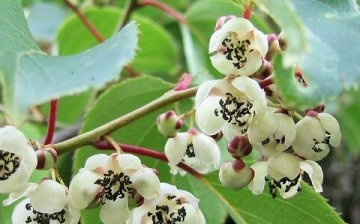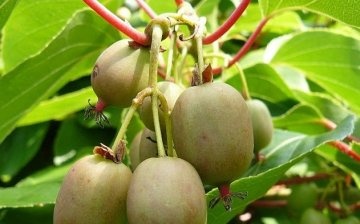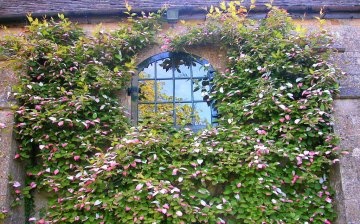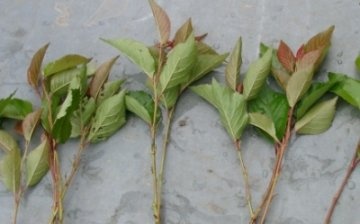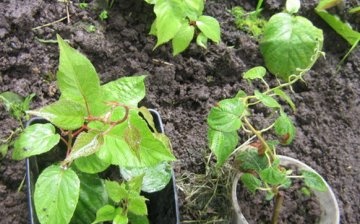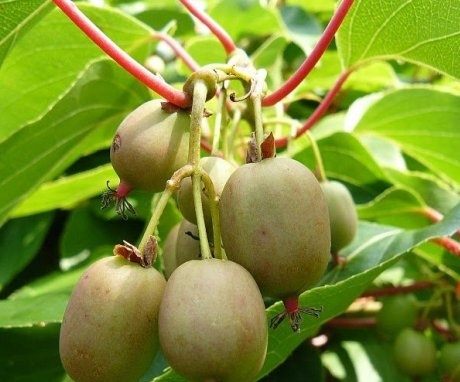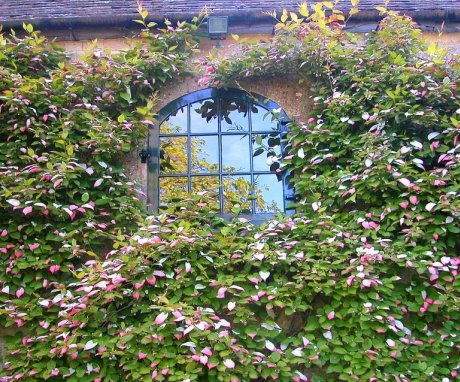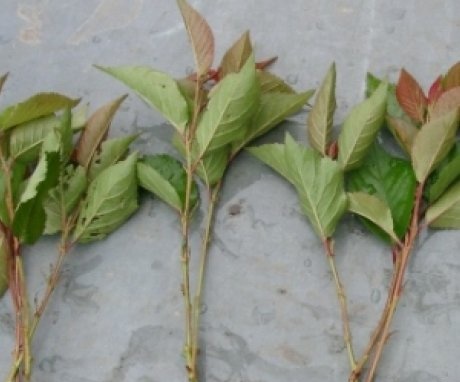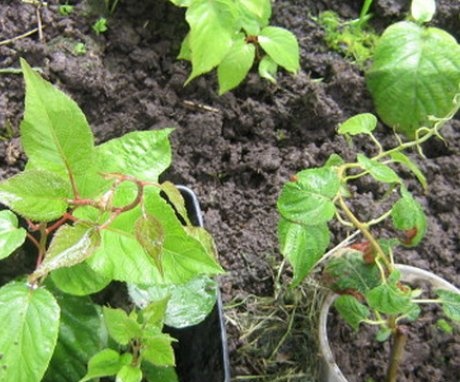What is actinidia and how to grow a vine in your own garden
Actinidia are woody lianas that belong to the Actinidia family. Not many people know that the kiwi that we love so much is one of the varieties of this genus and has the full name Actinidia kiwi (Chinese, gourmet). Kiwi is a bulky tree-like vines native to China.
Content:
- Description of actinidia arguta
- Other species and varieties of actinidia
- Reproduction of actinidia
- Features of growing and caring for actinidia
Description of actinidia arguta
Genus has about 40 species, which are most common in the Himalayas and the countries of Southeast Asia. Only 4 species of Actinidia grow on the territory of Russia, or to be more precise, in the Far East.
Description of the plant:
- In actinidia, arguta lianas are very massive, the width of one stem can reach 12 cm, and the length is 25 cm.
- In order for the vine to develop successfully at home, there must be special strong supports.
- Actinidia arguta has a feature that is absent in other species: throughout the summer, the color of the leaves remains uniform, and in the fall they turn bright yellow.
- Flowering period of actinidia arguta begins at the end of June. Only this species of actinidia has almost black pollen.
- Female and male inflorescences differ from each other, in the former the flower is single, in the latter the flower consists of three inflorescences.
Within a year, a young shoot can grow more than 2 meters in length.
The color of the stem of this species is pale gray. The top of the leaf plate is darker than the bottom. The vines are smooth to the touch, the lentils are long and light. As for the leaves, they are quite elastic, the structure is smooth and shiny.
Actinidia arguta gives rather large fruits.
The average weight of each one reaches from 5 to 10 g, but some can grow up to 15-18 g. If the fruits are not harvested, they can remain on the branches until frost. If the season is good, then more than 10 kg can be harvested from one vine. harvest, fully ripen by the beginning of September.
Other species and varieties of actinidia
Actinidia Colomita is the most common species, mainly growing:
- Under the conditions of home cultivation, the liana can reach a height of 4 m.
- The color of the leaves is bright, in summer their color becomes light crimson, which remains until the period of leaf fall.
- The plant is dioecious, which is why it is necessary to have both female and male individuals on the land.
- The flowering period begins at the end of May, the fruits themselves begin to appear in early August.
- The fruits are small, the weight of one is only half a gram, its shape can be round or oval, the color is green.
Actinidia polygamus came to us from Primorye:
- Liana grows up to 6 meters, leaves are wide, pointed ends.
- The leaves grow to a length of 15 cm, their main highlight is the silver tint, which does not leave the plant until the period of fruit ripening.
Actinidia Kolomikta tolerates frost well, it will not die even at a temperature of -45 degrees, so it can grow in any country. If you provide the plant with proper care, then its life cycle will last at least 50 years.
The fruits of actinidia polygamy are weighty, small in size, only 3 cm, and have a pleasant sweet aroma.
The peak of ripening occurs at the end of September, then the mass of one fruit is 8 g, at this moment the fruits are suitable for human consumption. The bitter aftertaste disappears only after freezing. It is difficult to grow this species, it loves warmth and does not tolerate winter well.
The Pavlovskaya variety was obtained thanks to actinidia kolomikte:
- The color of the fruits is green, the surface is ribbed, there are white stripes, by which the variety can be identified.
- Actinidia Pavlovskaya produces oval fruits, on the sides they are compressed. The fruits are very fragrant and tasty, an average yield of 2.5 kg comes from one bush.
Variety Excellent obtained from actinidia kolomikta:
- Liana grows up to a maximum of 8 meters.
- Leaves are variegated, fruits are small, ribbed, with a sour taste.
- One tree can harvest 2.5 kg.
Variety Kievskaya large-fruited obtained using actinidia purpurea and arguta:
- The bush grows very large, some especially reach a height of 20 m.
- The fruit is juicy and soft, and has some flavor similarities to pineapple.
- The fruits are large, each weighing 15-20 g.
Reproduction of actinidia
The reproduction of actinidia is carried out using:
- Green or already lignified cuttings.
- Layers.
- Root offspring.
- Dividing the bush.
- Vaccinations.
- Seed.
That is, any methods may be suitable for the reproduction of actinidia, the main thing is to know the peculiarity of each of them. Seed propagation is practiced but it is ineffective. In most cases, males grow from seeds, and this can be understood at least 5 years later, when the flowering period begins.
With the help of root shoots, only actinidia kolomikta and polygamy can be obtained, other species and varieties simply do not have root shoots.
If reproduction will be carried out by lignified cuttings, then they must first be prepared. This is done at the end of winter or after spring pruning. Only annual, well-ripened growths, no more than 70 cm long, are suitable for reproduction. They must be placed in boxes with sand in a room where the temperature does not rise above 2 degrees. At the beginning of spring, cuttings of 20 cm long are made of them and planted, the scheme of 60 * 5 cm is observed. The soil optimal for growing cuttings is light with a high content of sand. Until the stalk is rooted, it is covered with foil.
Reproduction by layering is carried out in May.
Last year's shoots are laid in grooves, the depth of which is 10 cm. Already in the third year, the layers can be transplanted to a permanent place, before that, young shoots are simply spud.
The most popular way to propagate actinidia is with green cuttings:
- To do this, you will need to organize a greenhouse (made of film or glass) or have an installation for creating fog and a greenhouse.
- Cuttings are harvested in June, cut into 10 cm pieces and planted in a substrate that consists of peat and sand in equal parts.
- It is good if the humidity of the room reaches 95% and the temperature is more than 25 degrees.
Features of growing and caring for actinidia
For actinidia, a bright, high area is suitable, it is good if it is a slope with a water drain.
The most favorable soils: fertile, loamy, with a good humus horizon. Liana will be larger if the soil is acidic or slightly acidic; it is strongly discouraged to plant actinidia on floating clay soil. It is better to plant actinidia in April, for the winter we cover the seedlings with a large layer of fallen leaves. When planting, a hole is dug about 50 cm, the width between the rows should be about 4 meters, between the bushes about 3. Immediately after planting, the plant must be protected from direct sun.
Immediately after planting, the bush is watered with 5-7 liters of water, then abundant, regular watering is provided.
In hot weather, it is advisable to spray the liana.Before planting, about 10 kg of organic fertilizer is applied to the pit, mineral fertilizers are applied twice a year, at the end of April and in mid-September. The fertilizer should not contain chlorine.
If we consider leaving by month, the calendar will look like this:
- In April, shelters are removed, rooted cuttings are planted in a permanent place.
- In May, organic and mineral fertilizers are applied, the soil is loosened, the roots are mulched, and the shoots are tied up.
- In June, the soil is loosened, the earth is added, cuttings are cut and rooted.
- In July, the soil is loosened, watered, tied up shoots, remove unnecessary shoots.
- In August, they loosen the soil, harvest, fertilize after harvesting the fruits.
- In September, they harvest, remove diseased fruits.
- In October-November, plants are cut, young plants are covered for the winter.
BUTpest resistant ctinidia, she is rarely affected by disease. Only at the end of summer, dark spots can appear on the leaves; to combat this problem, the leaves are simply removed. Only cats are the main enemy of actinidia, they can sneak into the garden and gnaw young shoots, as well as dig in the roots.
More information can be found in the video.



